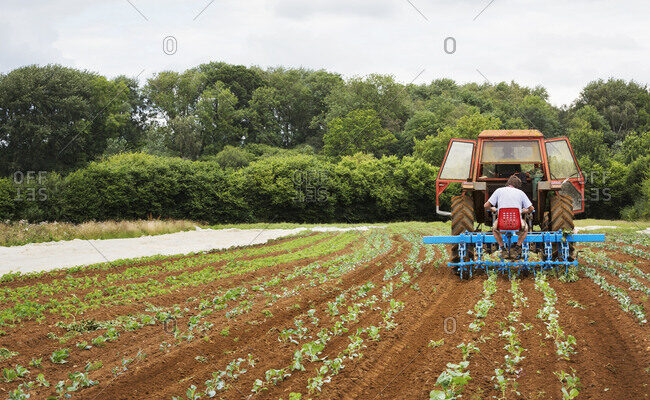It is rewarding to grow your own fresh flowers and vegetables.
You’ll need to rent or buy some equipment in order to prepare your soil before planting.
You must know the differences between a tiller and a cultivator to use the correct tool for loosening and amending your soil.
This guide will give you the “dirt”, on how to use cultivators and tillers. Keep reading!
What is a tiller?
The garden tiller, or rototiller, is a machine powered by electricity or gas that has hard metal blades to break up the soil into smaller pieces. This is also called rototilling the ground.
At the ends, the blades are curved inward, which makes it easier to create new planting beds or garden plots.
The tiller can be used to break down large lumps of soil, but it won’t produce a fine texture.
Two types of garden tillers are available. Front-line tillers are ideal for gardens with average soil.
Front-line tillers are designed with the wheels located behind the tines. This makes it easier to maneuver the unit during operation. The size of the tiller is smaller, making it easier to store and transport.
Rear-tine tillers can be used for large areas of very hard or rocky soil. This garden tiller has wheels in front and is bigger, heavier, and more powerful than a front-line model. This design makes it difficult to move the unit around the garden.
What is a tiller used for?
The best tillers for:
- Breaking up hard, untouched soil
- Cutting through rocks, weeds, and roots
- Remove/grind weeds
- Breaking ground
How does a tiller work?
Tillers can be very effective in treating “rough” soil. The machine digs deep into the soil and raises dirt clumps to the surface.
Most tillers do not produce soil that is ideal for growing vegetables or flowers.
Breaking through tough debris.
Tiller blades are capable of cutting through even the toughest foliage and small roots. A tiller can be used to clear plots of land of grasses, weeds, or saplings.
You may find that debris can get caught in the tines. However, the majority of the time, large chunks of weeds or roots will fall out onto the surface and be easily removed.
Weed destroyer.
Tiller blades are able to grab weeds as they travel over the ground.
The weeds will be shredded and incorporated into the soil if you continue to move the ground in various directions.
While preparing the soil to plant, this process will improve soil texture and nutrients.
Some models of tillers allow you to adjust the blade depth so that you can use them for surface weeds instead of digging deep.
Best time to use a tiller.
Use a tiller to loosen up compacted soil and weeds in your garden before planting. Use a tiller on dry soil. Wet soil can clog the tines of the tiller and cause a mess.
What is a cultivator?
A cultivator is an agricultural or gardening tool used for secondary soil tillage.
Some manufacturers of garden tools combine the functions of a tiller and a cultivator into one tool, leaving you with only mediocre results.
It is for this reason that serious gardeners choose to purchase a cultivator in addition to other gardening equipment, as the tool can be extremely useful during the growing seasons.
The machine has a frame that is covered with teeth or shanks around a long cylindrical, which pokes and stirs the soil when it rolls over.
The teeth on a cultivator have a close spacing, which helps to clear the soil.
Use a cultivator before and after you plant for many of the uses that I will discuss below.
There are a variety of sizes, but most gardeners use a powered push-behind machine which is easy to maneuver in small spaces.
Pull-behind cultivator models that attach to your tractor or riding lawnmower are also available.
What is a cultivator used for?
Cultivators can be used in the garden before planting, like:
- Prepping soil
- Remove or bury weeds
- Beds or rows sculpted
- Aeration
- Soil preparation
How does a cultivator work?
Cultivators are used to break up the compaction of soil, allowing water to reach the roots. This tool breaks up clumps to make the soil softer and easier for you to work on.
The soil will also be fertilized with compost and fertilizer by the cultivator.
Cultivators can also be used to remove large debris such as sticks, weeds, and roots.
Weed control.
The teeth of a cultivator are designed to remove broad-leaf roots and entire weeds as the machine travels over them. This feature eliminates the need to go down in your garden and pull out weeds.
The cultivator can be used to remove smaller weeds by tearing them off the surface of the soil and turning them into the top few inches.
By incorporating the plants in the soil, you can quickly control the growth of weeds in large areas of your garden, such as between rows. The weeds that are incorporated into the soil also provide nutrients to your garden.
Making rows.
Some cultivator models come with interchangeable attachments, such as discs or blades that are used to plough garden soil into rows.
The disk attachments can also be used to create trenches for perfect seed rows. The furrow next to the trench can be pushed over the seeds quickly for planting.
Aeration.
Cultivators are experts at breaking up dirt to bring beneficial aeration into the soil. Aeration is essential for healthy root and plant growth.
When is the best time to cultivate?
For best results, use the cultivator only when the soil has slight moisture. Parched soil is difficult to break and can even bend the metal tooth.
The soil will compact and dry up if it is wet, especially if there is a lot of clay in the soil. This will inhibit plant growth.
In summary.
This guide will help you understand the differences between cultivator and tiller machinery so that you can choose the right tool for your gardening requirements.
Both tools are useful in the home garden, but for optimal soil, I don’t think there is any competition between a tiller and a cultivator.
You’ll have more success growing flowers and vegetables in your own garden if you are familiar with gardening equipment.












Comments